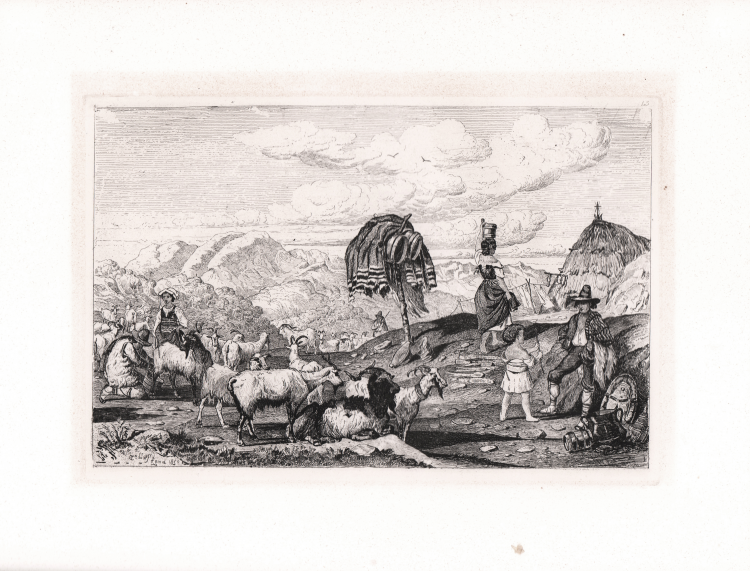



| Reference: | S5609 |
| Author | Charles COLEMAN |
| Year: | 1850 |
| Measures: | 275 x 185 mm |


| Reference: | S5609 |
| Author | Charles COLEMAN |
| Year: | 1850 |
| Measures: | 275 x 185 mm |
Etching from the 'A series of subiects peculiar to the campagna of Rome and Pontine marshes designed from nature and etched by C. Coleman', printed in Rome in 1850.
A fine work, printed on China paper and laid on cardboard, full margins, in perfect condition.
Charles Coleman was an English landscape and animal painter, born in Pontefract, Yorkshire, England. He was active primarily in Rome, where he was an important influence on Nino Costa and made a significant contribution to the formation of the School of "Campagna Romana" Painting. From the barren hills of Yorkshire, Charles Coleman arrived in Rome in 1831 and showed himself a passionate painter of the territory surrounding the urbe, publishing in the middle of the century, at the Spithover bookstore, a rich volume with 53 etchings: A series of subiects peculiar to the countryside of Rome and Pontine marshes designed from nature and etched by C. Coleman. The landscapes that Coleman depicts are very similar to the desolate views of his Yorkshire, "windy and inhabited only by heather".
In most of the English artist's views, the landscape is presented with vivid contrasts, making Coleman a true master for a generation or two of painters in Rome and beyond.
He was contemptuous of academic teaching, believing that observation from nature was the best education for an artist. He exhibited five times at the Royal Academy in London, for the last time in 1869.
Charles COLEMAN (Pontefract 1807 ca. - Roma 1874)
|
Charles Coleman (c. 1807 – 1874) was a British landscape and animal painter, born in Pontefract, in Yorkshire, England. He was active principally in Rome, where was an important influence on Nino Costa and made a significant contribution to the formation of the Campagna Romana School of painting. Coleman first went to Rome in 1831 to study the paintings of Michelangelo and Raphael. He became permanently resident there in 1835, and on 21 June 1836 married Fortunata Segadori (or Segatori) from Subiaco, who, along with Vittoria Caldoni of Albano, was one of the most famous Roman models of the time. Segadori had sat for August Riedel; a portrait of her by Johann Heinrich Richter is in the Thorvaldsen Museum in Copenhagen. The couple had eight children; their son Enrico Coleman (1846–1911), was also a landscape painter, in oils and watercolour, as was the younger and less well-known Francesco Coleman. The Colemans' first address was 25 via Zucchelli. In 1869 the family moved to 16 via Zucchelli, and for the first time Coleman set up a separate studio, at 33 via Margutta, possibly with the intention of providing space for his two painter sons. Four of his paintings, dated from 1845 to 1847 and all featuring buffaloes, are listed in the catalogue of the collection of Beriah Botfield. From 1848 to 1850 he made etchings of scenes and animals in the Campagna Romana, and these were published in 1850 as A Series of Subjects peculiar to the Campagna of Rome and Pontine Marshes, designed from nature and etched by C. Coleman. He was dismissive of academic teaching, believing that observation from nature was the best education for an artist. He exhibited five times at the Royal Academy of London, for the last time in 1869. Coleman remained largely unknown in his native country but became a major influence on the Italian landscape painter Nino Costa, whom he met in the Campagna in the early 1850s. Coleman was considered the founder of the "Campagna Romana" school of painting in Italy. He died in Rome in 1874.
|
Charles COLEMAN (Pontefract 1807 ca. - Roma 1874)
|
Charles Coleman (c. 1807 – 1874) was a British landscape and animal painter, born in Pontefract, in Yorkshire, England. He was active principally in Rome, where was an important influence on Nino Costa and made a significant contribution to the formation of the Campagna Romana School of painting. Coleman first went to Rome in 1831 to study the paintings of Michelangelo and Raphael. He became permanently resident there in 1835, and on 21 June 1836 married Fortunata Segadori (or Segatori) from Subiaco, who, along with Vittoria Caldoni of Albano, was one of the most famous Roman models of the time. Segadori had sat for August Riedel; a portrait of her by Johann Heinrich Richter is in the Thorvaldsen Museum in Copenhagen. The couple had eight children; their son Enrico Coleman (1846–1911), was also a landscape painter, in oils and watercolour, as was the younger and less well-known Francesco Coleman. The Colemans' first address was 25 via Zucchelli. In 1869 the family moved to 16 via Zucchelli, and for the first time Coleman set up a separate studio, at 33 via Margutta, possibly with the intention of providing space for his two painter sons. Four of his paintings, dated from 1845 to 1847 and all featuring buffaloes, are listed in the catalogue of the collection of Beriah Botfield. From 1848 to 1850 he made etchings of scenes and animals in the Campagna Romana, and these were published in 1850 as A Series of Subjects peculiar to the Campagna of Rome and Pontine Marshes, designed from nature and etched by C. Coleman. He was dismissive of academic teaching, believing that observation from nature was the best education for an artist. He exhibited five times at the Royal Academy of London, for the last time in 1869. Coleman remained largely unknown in his native country but became a major influence on the Italian landscape painter Nino Costa, whom he met in the Campagna in the early 1850s. Coleman was considered the founder of the "Campagna Romana" school of painting in Italy. He died in Rome in 1874.
|